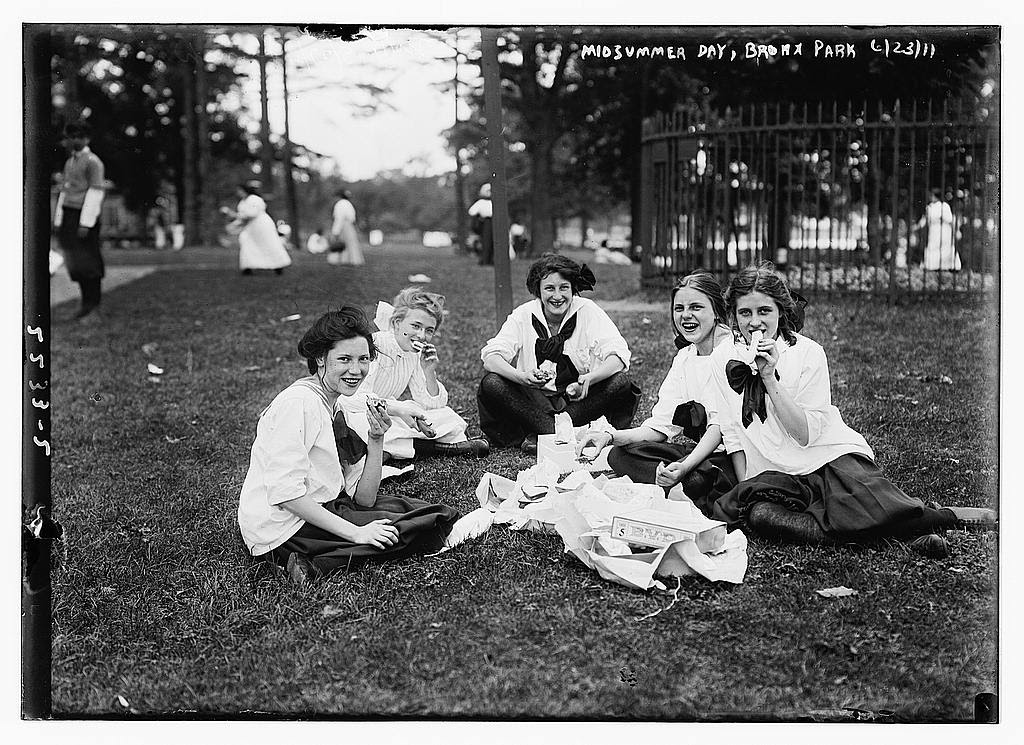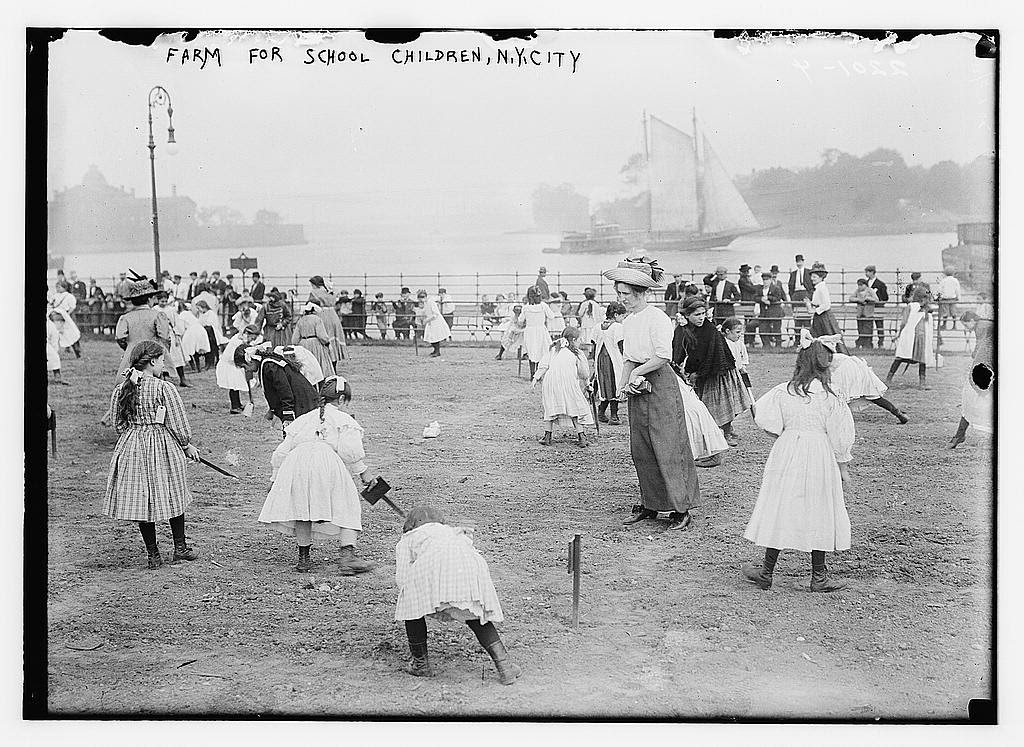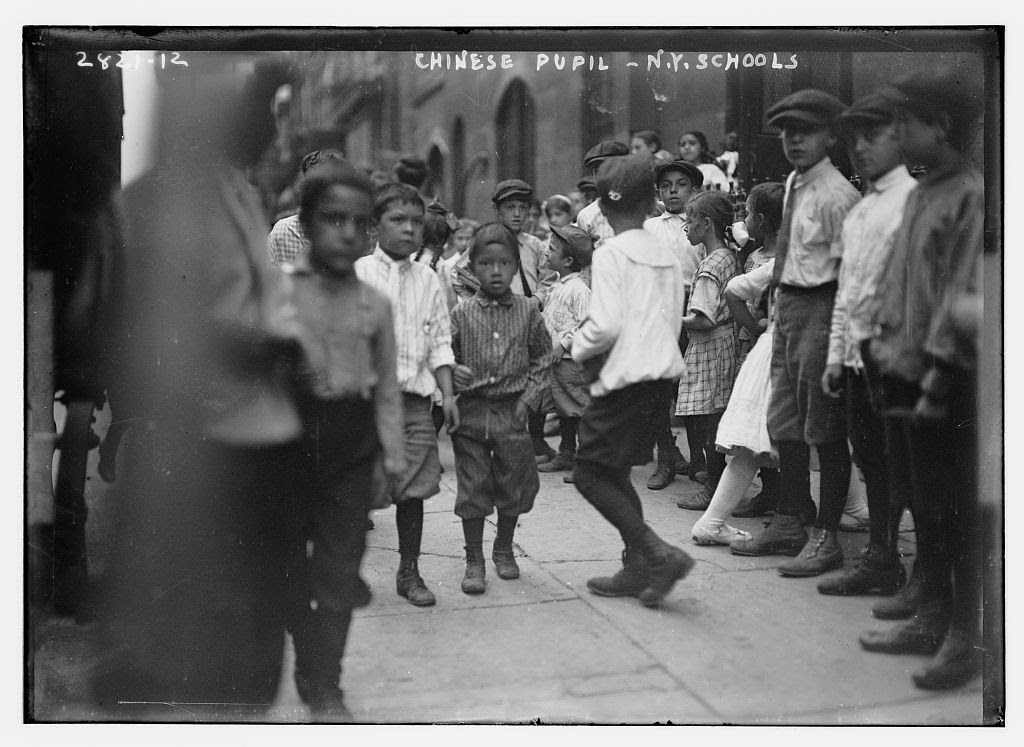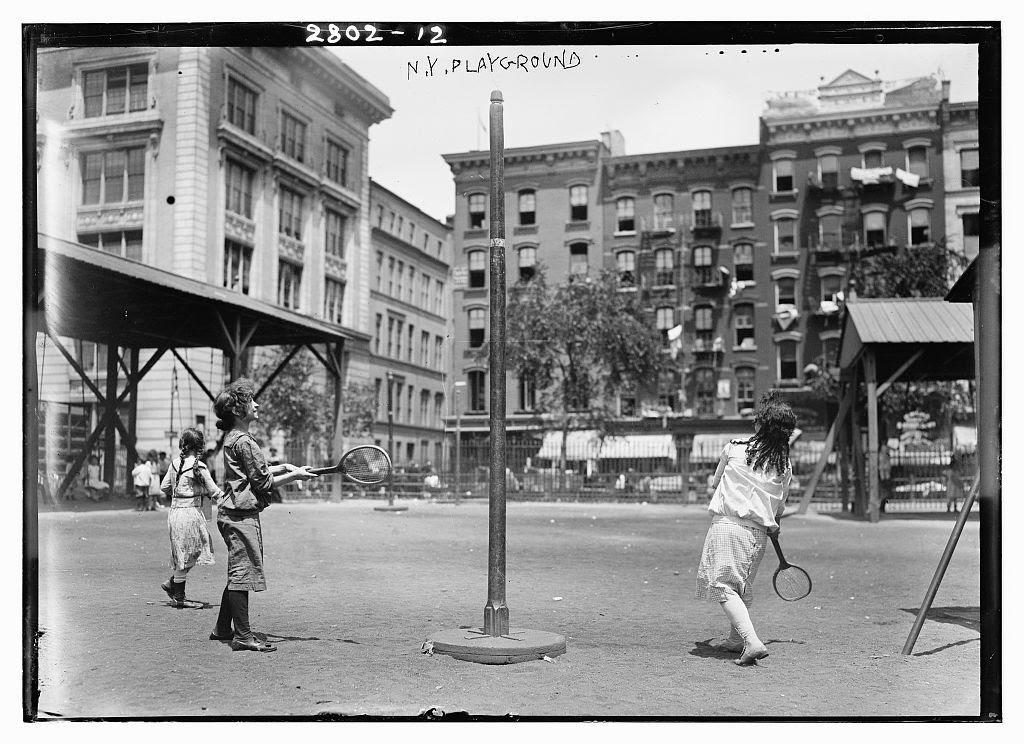.

Public Schools Athletic League: photographer unknown for Bain News Service, 23 May 1912 (George Grantham Bain Collection, Library of Congress)
I went to School
But was not wiser
Globe did not teach it
Nor Logarithm Show
“How to forget”!
Say — some — Philosopher!
Ah, to be erudite
Enough to know!
But was not wiser
Globe did not teach it
Nor Logarithm Show
“How to forget”!
Say — some — Philosopher!
Ah, to be erudite
Enough to know!
Emily Dickinson (1830-1886), from "Knows how to forget!", 1862 (?)

Public Schools Athletic League -- Central Park: photographer unknown for Bain News Service, 23 May 1912 (George Grantham Bain Collection, Library of Congress)

Central Park -- Maypoles -- Public Schools Athletic League celebration: photographer unknown for Bain News Service, 23 May 1912 (George Grantham Bain Collection, Library of Congress)

Midsummer Day Festival of the girls of Washington Irving High School, Pelham Bay Park in the Bronx: photographer unknown for Bain News Service, 23 June 1911 (George Grantham Bain Collection, Library of Congress)

Krakoviak dance. Photo shows girls from the Washington Irving High Schools, New York City, doing a Krakowiak dance from Krakow, Poland, at the Midsummer Day Festival which was held at Pelham Bay Park in the Bronx: photographer unknown for Bain News Service, 23 June 1911 (George Grantham Bain Collection, Library of Congress)

Pass-ball relay. Midsummer Day Festival of the girls of Washington Irving High School, Pelham Bay Park in the Bronx: photographer unknown for Bain News Service, 23 June 1911 (George Grantham Bain Collection, Library of Congress)

Carrying out a girl who fainted, pass-ball relay. Midsummer Day Festival of the girls of Washington Irving High School, Pelham Bay Park in the Bronx: photographer unknown for Bain News Service, 23 June 1911 (George Grantham Bain Collection, Library of Congress)

Rings and poles. Midsummer Day Festival of the girls of Washington Irving High School, Pelham Bay Park in the Bronx: photographer unknown for Bain News Service, 23 June 1911 (George Grantham Bain Collection, Library of Congress)

Deaf school children -- dancing: photographer unknown for Bain News Service, between 1910 and 1915 (George Grantham Bain Collection, Library of Congress)

Chinese school children -- Central Park: photographer unknown for Bain News Service, between 1910 and 1915 (George Grantham Bain Collection, Library of Congress)

Field Day -- B[rook]lyn Public Schools. ["Two Thousand Children in Various Athletic Exercises"]: photographer unknown for Bain News Service, 19 August 1913 (George Grantham Bain Collection, Library of Congress)

Ring-toss race -- Brooklyn Public School Children's Field Day: photographer unknown for Bain News Service, 19 August 1913 (George Grantham Bain Collection, Library of Congress)

Wheelbarrow race -- Brooklyn Public School Children's Field Day: photographer unknown for Bain News Service, 19 August 1913 (George Grantham Bain Collection, Library of Congress)

End of 100 yard final, Brooklyn Public School Children's Field Day: photographer unknown for Bain News Service, 19 August 1913 (George Grantham Bain Collection, Library of Congress)

Brooklyn Public School Children's Field Day: photographer unknown for Bain News Service, 19 August 1913 (George Grantham Bain Collection, Library of Congress)

Brooklyn Public School Children's Field Day: photographer unknown for Bain News Service, 19 August 1913 (George Grantham Bain Collection, Library of Congress)

Italian pupils -- New York schools: photographer unknown for Bain News Service, between 1910 and 1915 (George Grantham Bain Collection, Library of Congress)


Italian pupil -- New York school. ["Everytime I see an old picture like this I wonder what ever happened to the person. How was his life, where did he live, how old did he become? What's his story? We will never know..." -- Siebbi]: photographer unknown for Bain News Service,between 1910 and 1915 (George Grantham Bain Collection, Library of Congress)

Italians -- New York schools: photographer unknown for Bain News Service, between 1910 and 1915 (George Grantham Bain Collection, Library of Congress)

Jewish pupil -- New York school. [""Love his expression -- verge of a laugh? trying to stay still for the camera? But even more compelling is how his hat is a little too big for him." -- antiquerain]: photographer unknown for Bain News Service, between 1910 and 1915 (George Grantham Bain Collection, Library of Congress)

Children Planting in Thomas Jefferson Park, New York City. ["A children’s farm garden, one of many which flourished in parks in the first half of the 20th century, opened on May 20, 1911 with 1008 plots for children to grow flowers and vegetables. Designed as a place of respite for child laborers, the farm garden later hosted nature study classes and, during the World Wars, provided a lesson in self-sufficiency for local children...This view is looking from the East River, maybe from a recreational pier that was about there in the river, northwest across Jefferson Park to the corner of 113th St. and Pleasant Avenue." -- Art Siegel]: photographer unknown for Bain News Service, c. 20 May 1911 (George Grantham Bain Collection, Library of Congress)

Farm for school children, New York City: photographer unknown for Bain News Service, c. 20 May 1911 (George Grantham Bain Collection, Library of Congress)

Carlisle School -- printing shop. (United States Indian School, Carlisle, Pennsylvania]: photographer unknown for Bain News Service, between 1910 and 1915 (George Grantham Bain Collection, Library of Congress)

Carlisle School -- tin shop. (United States Indian School, Carlisle, Pennsylvania] ["Pretty likely a shot of the Carlisle Indian Industrial School. 'The so-called “noble experiment” was a failed attempt to forcibly assimilate Native American children into the culture of the United States. The United States Army War College now occupies the site of the former school.'" -- Randy Reiss]: photographer unknown for Bain News Service, between 1910 and 1915 (George Grantham Bain Collection, Library of Congress)

Lincoln Agricultural School for Boys, Lincolndale, New York. Photo shows the Lincoln Agricultural School for Boys, a Catholic charity opened in 1912 for training orphans. On negative: [E]very cow is credited with the amount of milk [it produc]es. ["Lincolndale Agricultural School for Boys was a Catholic charity run under a Brother Barnabas, opened in 1912 for selected orphans to be trained for agricultural and industrial work. On 9 March 1913, Brother Barnabas was quoted in the New York Times, [speaking] at a conference on vocational schools... against profit-making in such institutions, saying "It is a step backwards when we take those who are not able to support themselves and make them support us. Surely if they are able to support others they are able to go out into the community where they can work for themselves. The minute that a boy is self-supporting his place is in society and in a good home." -- pennyrichardsca (now at ipernity)] : photographer unknown for Bain News Service, sometime in 1913 (George Grantham Bain Collection, Library of Congress)


Carlisle School -- tin shop. (United States Indian School, Carlisle, Pennsylvania] ["Pretty likely a shot of the Carlisle Indian Industrial School. 'The so-called “noble experiment” was a failed attempt to forcibly assimilate Native American children into the culture of the United States. The United States Army War College now occupies the site of the former school.'" -- Randy Reiss]: photographer unknown for Bain News Service, between 1910 and 1915 (George Grantham Bain Collection, Library of Congress)

Lincoln Agricultural School for Boys, Lincolndale, New York. Photo shows the Lincoln Agricultural School for Boys, a Catholic charity opened in 1912 for training orphans. On negative: [E]very cow is credited with the amount of milk [it produc]es. ["Lincolndale Agricultural School for Boys was a Catholic charity run under a Brother Barnabas, opened in 1912 for selected orphans to be trained for agricultural and industrial work. On 9 March 1913, Brother Barnabas was quoted in the New York Times, [speaking] at a conference on vocational schools... against profit-making in such institutions, saying "It is a step backwards when we take those who are not able to support themselves and make them support us. Surely if they are able to support others they are able to go out into the community where they can work for themselves. The minute that a boy is self-supporting his place is in society and in a good home." -- pennyrichardsca (now at ipernity)] : photographer unknown for Bain News Service, sometime in 1913 (George Grantham Bain Collection, Library of Congress)

Commissary school class for cooks, U.S. Naval Training Station, Newport, Rhode Island: photographer unknown for Bain News Service, between 1910 and 1915 (George Grantham Bain Collection, Library of Congress)

Scrub and wash clothes, U.S. Naval Training Station, Newport, Rhode Island. ["As much as I love photography, I also hate it because we'll never get images like this again. People now are exposed to images of others and have become completely self-conscious and self-aware because of it. Most of these boys had probably only seen a handful of photos at this point. There's still such an easiness in front of the camera - they don't know that they "should" look a certain way. They just look the way they look and people accept them for it. There are a few looking at the camera, but I think it's more out of curiosity than anything else - maybe a feeling of "I can't believe someone's making a picture of me."-- Horse N. Buggy]: photographer unknown for Bain News Service, c. 1910 (George Grantham Bain Collection, Library of Congress): photographer unknown for Bain News Service, between 1910 and 1915 (George Grantham Bain Collection, Library of Congress)

Class room, U.S. Naval Training Station, Newport, Rhode Island: photographer unknown for Bain News Service, between 1910 and 1915 (George Grantham Bain Collection, Library of Congress)

Physical training exercises, U.S. Naval Training Station, Newport, Rhode Island: photographer unknown for Bain News Service, between 1910 and 1915 (George Grantham Bain Collection, Library of Congress)

Scrub and wash clothes, U.S. Naval Training Station, Newport, Rhode Island. ["As much as I love photography, I also hate it because we'll never get images like this again. People now are exposed to images of others and have become completely self-conscious and self-aware because of it. Most of these boys had probably only seen a handful of photos at this point. There's still such an easiness in front of the camera - they don't know that they "should" look a certain way. They just look the way they look and people accept them for it. There are a few looking at the camera, but I think it's more out of curiosity than anything else - maybe a feeling of "I can't believe someone's making a picture of me."-- Horse N. Buggy]: photographer unknown for Bain News Service, c. 1910 (George Grantham Bain Collection, Library of Congress): photographer unknown for Bain News Service, between 1910 and 1915 (George Grantham Bain Collection, Library of Congress)

Class room, U.S. Naval Training Station, Newport, Rhode Island: photographer unknown for Bain News Service, between 1910 and 1915 (George Grantham Bain Collection, Library of Congress)

Physical training exercises, U.S. Naval Training Station, Newport, Rhode Island: photographer unknown for Bain News Service, between 1910 and 1915 (George Grantham Bain Collection, Library of Congress)

Dr. Hartman's Sunday School Method: photographer unknown for Bain News Service, between 1910 and 1915 (George Grantham Bain Collection, Library of Congress)

Model of a $10,000 Sunday School by Dr. Hartman: photographer unknown for Bain News Service, between 1910 and 1915 (George Grantham Bain Collection, Library of Congress)

Raja Yoga Sunbeams, a group of children of the Raja Yoga Academy, San Diego, California: photographer unknown for Bain News Service, between 1910 and 1915 (George Grantham Bain Collection, Library of Congress)

Roof, Lenox Hill Settlement, New York City: photographer unknown for Bain News Service, c. 1915 (George Grantham Bain Collection, Library of Congress)

Chinese pupils -- New York school. ["This is likely a view of Mott Street, in the Lower East Side of Manhattan... The New York Chinese School was at 64 Mott Street -- just down the block -- as of 1929." -- Michael Deddino]: photographer unknown for Bain News Service, 8 September 1913 (George Grantham Bain Collection, Library of Congress)

Chinese pupils -- New York school: photographer unknown for Bain News Service, 8 September 1913 [?](George Grantham Bain Collection, Library of Congress)

New York schools -- opening: photographer unknown for Bain News Service, 8 September 1913 (George Grantham Bain Collection, Library of Congress)

New York schools -- opening: photographer unknown for Bain News Service, 8 September 1913 (George Grantham Bain Collection, Library of Congress)

New York schools -- opening: photographer unknown for Bain News Service, 8 September 1913 (George Grantham Bain Collection, Library of Congress)

New York schools -- opening: photographer unknown for Bain News Service, 8 September 1913 (George Grantham Bain Collection, Library of Congress)

Opening of schools, New York City: photographer unknown for Bain News Service, 8 September 1913 (George Grantham Bain Collection, Library of Congress)

Opening of schools, New York City: photographer unknown for Bain News Service, 8 September 1913 (George Grantham Bain Collection, Library of Congress)

New York City playground: photographer unknown for Bain News Service, between 1910 and 1915 (George Grantham Bain Collection, Library of Congress)
Tom,
ReplyDeleteSeeing this photos,one can't help but go back..living the making of something grand,a dream on every underlip,a rapid belief in everything unrolled as part of a program-to not fain meant you were a survivor(already a competition won-an ego boost)
Making a living now,rolling the underlip inward and fainting almost inadvertently at every cross-check of the continuity algorithm..
An epoch of optimism, patriotism, self-reliance, hope, ambition,
ReplyDeletepurpose....
And, geez, an absence of obesity.
Many thanks, Manik and Red.
ReplyDeleteLooking at a thousand photos to prepare this post was surprisingly happymaking, as is the experience of looking at it now that the weeks of labour are over and the red eyeballs and swollen knobbly digits have ceased complaining about it all.
The absence of smartphones, of "security" (well, there are the helpful bowler-hat policemen carrying off the collapsed pass-ball girl, but still), of frantic moms parked outside the schoolgrounds in SUVs -- and yes, Red, of that particular blight of bloat which seems to have fallen over the indulged, airbrained, supertech children of the future, much as an endarkening mantle -- makes these pictures a joy.
Innocence and sincerity and wonder we should no longer expect to find in this world, even in kids, I guess. But oh, that dizzying pleasure of the first day out of school. There appears a distinct memory of one such day. Pack of kids loitering on a patch of city parkway greensward, playing mumblety-peg. The pocket knife sticking in the grass, the dandelion profusion, and the delicious sense of total relief, the pure joy of temporary release from all forms of order and discipline (aka the necessary iron regime of the nuns).
For about two hours... before that familiar itch to get into trouble set in.
It ought to be remembered that in this period, not all children got to go to school. Circumstances forced many into the streets and into various taxing forms of labor. The heroic work of a single great photojournalist with the mind and vision of a social reformer, Lewis Hine, documenting the ragtag out-of-school lives of the children of a century ago for the American Child Labor Committee, was instrumental in getting legislation passed that ensured kids would be in some kind of school, somewhere, or at least not out toiling for a living while still in short pants.
ReplyDeleteLewis W. Hine: Where the Boys Are
Lewis W. Hine: An Enforced Rest
Lewis W. Hine: Child Labor, Kentucky, 1916
Lewis W. Hine: Child Scavengers
Lewis W. Hine: Cotton ("She jess works fer pleasure")
Lewis W. Hine: Day's Work of the Humphrey Children, Elizabethtown, Kentucky
Lewis W. Hine: Exposure ("get father a watch")
Lewis W. Hine: Junk Gatherers (Just Kids)
Lewis W. Hine: Truant Newsboys, Oklahoma City ("didn't know his name")
Tom,
ReplyDeleteThe expressions of the children in these photographs are arresting. Every emotion is registered from determination to suspicion to terror to joy--even in a single photograph, the first one from the Italian school. School, for those who were able to go, was undoubtedly highly regimented 100 years ago, but still there seems to have also been a belief in the value of play. Exactly what's being squeezed out of school at the expense of "standards" and "accountability." Ah, well, summer is almost here... Field day!
-David
Thanks very much, David.
ReplyDelete"Field Day" was the working title for the post, which I'd forgot -- so thanks for seeing what was meant to be said.
And that tremendous photo of the Italian pupils, representing a whole gamut of human emotions, each distinct and credible, as these young people hover at the brink of becoming the grown-ups we can almost recognize already -- while at the same time wondering about all the baggage of circumstance, contingency and accident we can't yet figure into the equation, as we see these young people preparing somehow to go out into a world.
It's plainly a New World, for them, but still the term "knowable community" comes to mind -- or perhaps that's merely what I want to think I am seeing, in a picture like that one.
Tom, another brilliant post for which I am grateful. My father was born in 1899 to Irish immigrant peasant parents and dropped out of school in seventh-grade to go to work, which included more than one job, like newsboy and "sweeper upper"—as he would say—in a hardware store. He bought that store from the owner when he was 21 and was a big success through the 1920s, then lost everything in The Depression, when, as he used to say, "The big boys bought it off me for a dime on the dollar, and sometimes a nickel." Ended up over a garage with my mother and three oldest brothers until an accidental fire in their one little wood burning stove burnt the garage down and then had to stay on others' couches etc. He ended up with a little home repair business I went to work in as a boy for my "room and board" every day after school and Saturdays (I worked regular jobs as a busboy etc. on Sundays and in the evenings) and was happy to leave behind when I left home at 18 to "make my mark" as I saw it. Just a little story of what one of those lives in the photos may have turned out to be like, and on of their children.
ReplyDeleteThey are wonderful photos - fascinating to see the variety of approaches to education from the Noble Experiment to the Raja Yoga Sunbeams.
ReplyDeleteThe shot of the Italian kids is most enchanting.
This Beckett poem came to mind (as an echo of Dickinson):
Spend the years of learning squandering
Courage for the years of wandering
Through a world politely turning
From the loutishness of learning.
On an uglier note, read this report recently.
Duncan,
ReplyDeleteThat Beckett poem does indeed come closer than the Dickinson to fitting this post.
The kids breathing that bad nicotine air will probably remember it forever, in their cells.
And as to the loutishness...
Michael,
I hear you. These are our histories, such as they are. My own maternal grandparents came over from "the old country" in that same epoch. The point of entry, in all these cases, would have been New York. My grandmother, eldest child of a family that ran a country store in County Westmeath, came over first, cleaned people's houses (standard work, of course, for all Irish immigrant girls of the period), sent a bit of her earnings back home to assist in the transportation of the next child in line, then went West, and in Chicago met up with my grandfather, whose family had come over from Kerry to the Dakotas, and who had done and would do those kinds of work young Irishman then did -- demanding physical labor, first lighting gas lamps in the street, then driving a streetcar, finally becoming a policeman.
My grandfather often joked that he was a graduate of the best school in the world, "the School of Hard Knocks". While explaining this, he would, in kindly fashion, dig his enormous fist into my feeble little bicep, as if to drive home his point.
I spent a fair share of my own childhood at my granparents' house. They were both up before dawn every day, and off to work (in his case) or Mass (in hers, before the housework chores began).
For me, the lives and struggles of those people, and the millions like them, now seem as remote as events on another planet.
Approaching my own departure from this world, I'm embarrassed to acknowledge that nothing I've ever done can ever stand up to that standard of common effort.
This is a topic that makes oldtimers like ourselves into cartoons of ourselves, I guess -- always whinging about the deficiencies of the young. On a radio talk show this morning, I heard a fellow complaining that he'd taken his kids to a miniature golf course.
"There were a lot of kids there. The girls were having fun. The boys -- what's happened to little boys? They were swinging those putters like drivers, I kept having to duck to get out of the way of the backswings. And their dads just stood there. What's happened to spanking? It's the only way little boys ever learn anything. I spank my kids all the time, in public if I have to. Other parents gape at me as though I were a serial killer."
(The speaker of those words: ex-major league baseball player Aubrey Huff.)